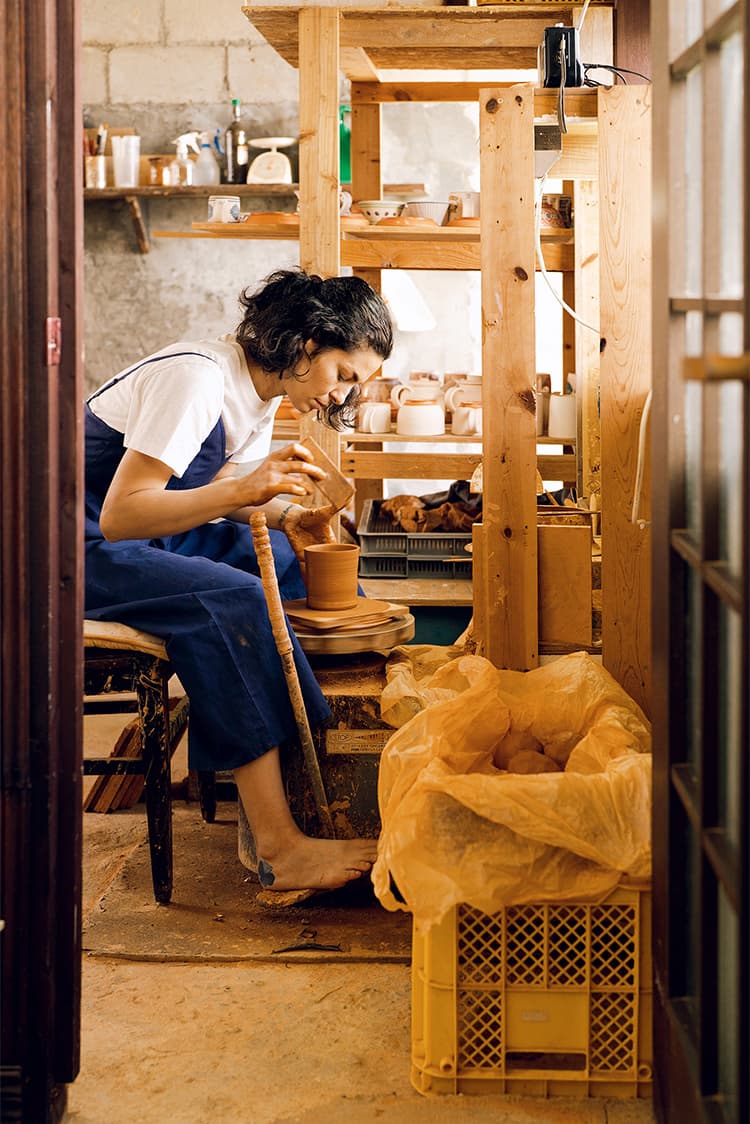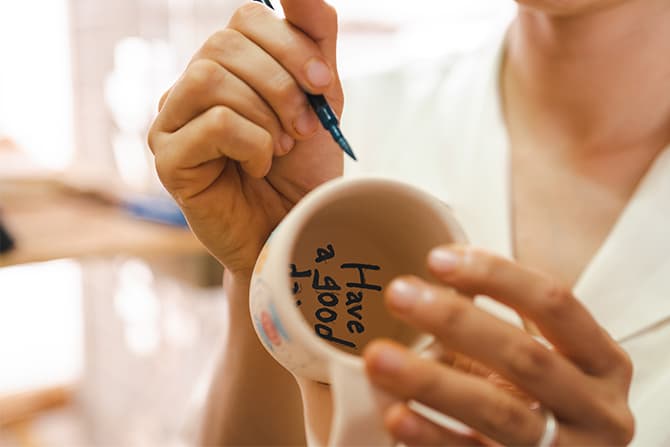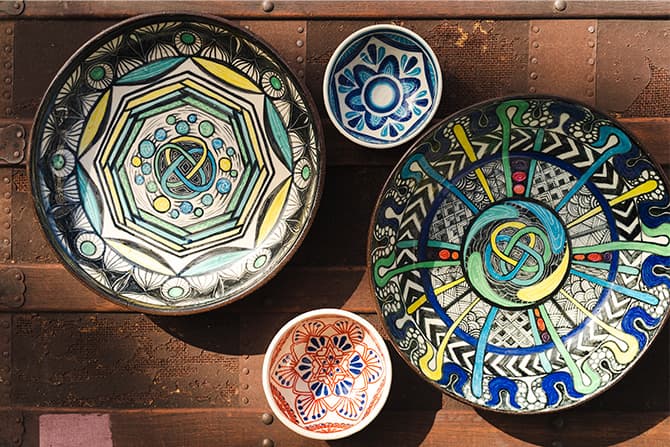Craftman_1
Catherine Lorimer
Potter
Born in 1985 on Ishigaki Island, Okinawa Prefecture. Catherine’s parents are both ceramicists. After moving from place to place, she returned home at twenty-seven to apprentice with her mother, Nami Lorimer. In 2021, she opened her own studio, NANTOUYAKI, in Okinawa City. She regularly exhibits work outside of Okinawa.

- Slub Jersey Crew Neck Cropped Short Sleeve T-Shirt
-
Linen Blend Camisole Jumpsuit
People and LifeWear
- Photography by Kazufumi Shimoyashiki
- Text by Keisuke Kagiwada
- Special thanks to Natsuki Akiyama
These two fascinating artisans spend their days making crafts from the graces of the natural world.
Craftman_1
Catherine Lorimer
Potter
Born in 1985 on Ishigaki Island, Okinawa Prefecture. Catherine’s parents are both ceramicists. After moving from place to place, she returned home at twenty-seven to apprentice with her mother, Nami Lorimer. In 2021, she opened her own studio, NANTOUYAKI, in Okinawa City. She regularly exhibits work outside of Okinawa.

- Slub Jersey Crew Neck Cropped Short Sleeve T-Shirt
-
Linen Blend Camisole Jumpsuit
At the start of 2022, a charming new studio and gallery opened its doors in the center of Okinawa City. NANTOUYAKI is operated by potter Catherine Lorimer in a 1960s-era house that she renovated herself.
“Growing up, my family always said ‘If you need it, make it’ and ‘If it breaks, fix it.’ We may have been poor, but we knew that with a little elbow grease, you could breathe new life into what someone else might throw away. I suppose that way of seeing the world is what made me want to renovate this house. I actually live out back. Initially the plan was just to rent the living space. But then my landlord said ‘Go ahead, you can use the space out front,’ so I took them up on it and made this part into a studio and gallery. The other day, one of the ladies in the neighbourhood took a break from her walk and sat down in a chair out front, so I struck up a conversation. In Okinawa, people are quick to make friends with people they don’t even know. I’d love for this to become a place where people from the neighbourhood can relax and unwind. Not a special or elite place, but truly a part of everyday life. Same goes for the plates and cups I make. They’re made to be used every day.”
Born and raised on Ishigaki Island, Catherine is the daughter of two ceramicists: Paul, who hails from New Zealand, and Nami, who is Japanese. In that sense, she comes from a ceramics family, but she started making pots fairly late, at twenty-seven. Catherine spoke to the reasons behind this circuitous route.
“No exaggeration, I grew up in the jungle of Ishigaki Island. Our house was like a cattle barn my dad built with his friends! It was fun when I was little, but in my teens I started to resent it. I couldn’t wait to get away. After dropping out of high school, I spent time living on the main island as well as Fujisawa and Kamakura, up in Kanagawa Prefecture, working in the restaurant and hotel industries.”
Up through her late twenties, Catherine led a busy life, moving from place to place. By the time her younger brother was heading off to study in New Zealand, their father’s homeland, she had begun to tire of this lifestyle. But joining him brought Catherine to a turning point in life.
 1
1-
Linen Blend Open Collar Short Sleeve Shirt
-
Cotton RELACO 3/4 Shorts
 2
21. The shelves of the gallery are lined with Catherine’s work. She hopes to offer coffee in the future. 2. While adding designs to a mug, Catherine writes “Have a good day” on the inside, hoping to make somebody smile.
Born and raised on Ishigaki Island, Catherine is the daughter of two ceramicists: Paul, who hails from New Zealand, and Nami, who is Japanese. In that sense, she comes from a ceramics family, but she started making pots fairly late, at twenty-seven. Catherine spoke to the reasons behind this circuitous route.
“No exaggeration, I grew up in the jungle of Ishigaki Island. Our house was like a cattle barn my dad built with his friends! It was fun when I was little, but in my teens I started to resent it. I couldn’t wait to get away. After dropping out of high school, I spent time living on the main island as well as Fujisawa and Kamakura, up in Kanagawa Prefecture, working in the restaurant and hotel industries.”
Up through her late twenties, Catherine led a busy life, moving from place to place. By the time her younger brother was heading off to study in New Zealand, their father’s homeland, she had begun to tire of this lifestyle. But joining him brought Catherine to a turning point in life.
“He and I moved into a place near Barry Brickell, the potter that my parents had studied under. Now and then we went over to his studio to hang out. I thought his work looked so fun, but I never asked him to teach me. A year later, when I was back on Ishigaki Island, I saw my mother making pots and thought it was the coolest thing that I had ever seen. Despite the fact I’d never thought of that sort of thing before. Maybe living abroad gave me the perspective that I needed to see my home in Okinawa with fresh eyes. Finally I told my mother ‘I think I want to try this,’ and she said ‘Okay, I’ll show you.’ That’s when I started making pots.”
For forty years, Catherine’s mother Nami has been firing pots in a style called “Nantouyaki” (South Island Ceramics). What sets her style apart are brightly coloured motifs depicting Okinawan flora and fauna. In her first years making pots, Catherine stuck to the traditional techniques, but at the age of twenty-nine, a trip with her parents to their mentor Barry’s studio revolutionised her approach.
 3
3 4
41. The shelves of the gallery are lined with Catherine’s work. She hopes to offer coffee in the future. 2. While adding designs to a mug, Catherine writes “Have a good day” on the inside, hoping to make somebody smile. 3. Works from her time spent training with Barry Bickell. “I don’t think I could make something this detailed now,” she says. 4. Catherine’s current work. Though all employ mandala motifs, the influence of Nantouyaki can be felt in the refreshing colours. ¥2,500〜
3. Works from her time spent training with Barry Bickell. “I don’t think I could make something this detailed now,” she says. 4. Catherine’s current work. Though all employ mandala motifs, the influence of Nantouyaki can be felt in the refreshing colours. ¥2,500〜
“He and I moved into a place near Barry Brickell, the potter that my parents had studied under. Now and then we went over to his studio to hang out. I thought his work looked so fun, but I never asked him to teach me. A year later, when I was back on Ishigaki Island, I saw my mother making pots and thought it was the coolest thing that I had ever seen. Despite the fact I’d never thought of that sort of thing before. Maybe living abroad gave me the perspective that I needed to see my home in Okinawa with fresh eyes. Finally I told my mother ‘I think I want to try this,’ and she said ‘Okay, I’ll show you.’ That’s when I started making pots.”
For forty years, Catherine’s mother Nami has been firing pots in a style called “Nantouyaki” (South Island Ceramics). What sets her style apart are brightly coloured motifs depicting Okinawan flora and fauna. In her first years making pots, Catherine stuck to the traditional techniques, but at the age of twenty-nine, a trip with her parents to their mentor Barry’s studio revolutionised her approach.
“Barry taught me to be free. ‘If you’re not having fun,’ he said, ‘you can’t get anything done. What’s the use in getting worked up?’ That was such a relief to hear. His studio was a gathering place for all kinds of ceramicists. Among them was a girl my age named Caitlin. Meeting her was huge for me. My current work blends eye-catching motifs from Nantouyaki with mandala-like designs. I’ve loved drawing ever since I was little, especially these kaleidoscopic figures. One day when Caitlin and I were having a beer, I showed her some of my sketches. ‘You should really use these in your ceramic work,’ she said. That’s how I started making the mandala ceramics. It all started with our reunion with Barry.”
As much as Catherine’s designs have evolved, they remain entrenched in the Nantouyaki tradition. This is abundantly clear from her use of hand-mixed Okinawan clay.
“My family has been making our own clay since I was little. Since I grew up thinking this was normal, I was actually surprised to find out you could buy clay in a store! Digging up the clay is tough work, and mixing it with water to the right consistency takes time. I always think how easy it would be to just go out and buy some clay. My mother’s health forces her to use clay from a store. So I figure that as long as I am able, I want to follow her example and make clay from Okinawan soil. This clay is fragile, though. It barely sticks together. It’s awfully hard to throw on a wheel. But this provides a welcome challenge. My hope is that whoever handles my creations will pick up on the atmosphere of Okinawa in some small way.”
Working up until this point at her mother’s kiln on Ishigaki Island, Catherine has since opened her own studio. The name NANTOUYAKI references the family tradition, but rather than write it using characters, Catherine opts for the alphabet.
“I came this close to using a completely different name. But after spending most of my twenties away from home, I wanted to do something to acknowledge my parents. So I asked my mother, ‘Do you mind if I call my place “NANTOUYAKI”?’ She was absolutely thrilled. My mum had been certain that the Nantouyaki name would end with her. Nantouyaki is a big part of what I do, but I’m also adding mandalas and my own original designs. To make a distinction, I decided to write NANTOUYAKI in letters. Luckily, my mum completely understood my point of view. I want to make ceramics for as long as I can. When I’m at work, my motto is ‘Smile at the everyday.’ That’s why I write little positive phrases like ‘Have a good day’ on my cups and mugs. When someone sees those words and smiles, as they finish with their drink or do the dishes, I’ve done my job.”

Nantouyaki
Studio and gallery in a renovated classic home. Large selection of ceramics to choose from.
2-2-38 Kubota, Okinawa-shi, Okinawa
What's Be.Okinawa?
Founded in 2013, Be.Okinawa is devoted to supporting local tourism. “Be” is about being present, prompting you to partake in an experience. This island is a place of beautiful nature and warm-hearted people, where you can be your true self. A place where travellers, whoever they might be, can soak up the fresh air, mingle with the locals, and connect from the heart.
https://beokinawa.jp/



